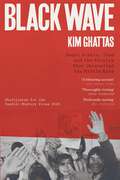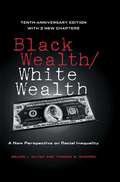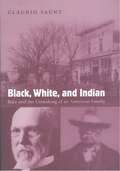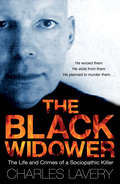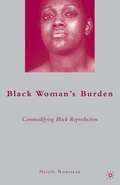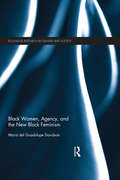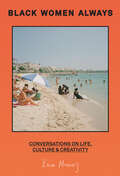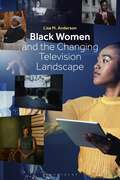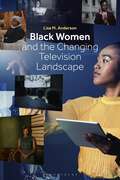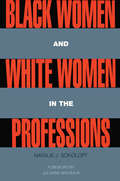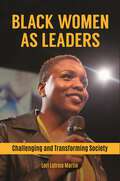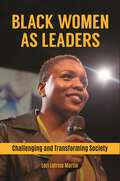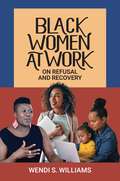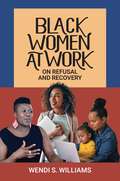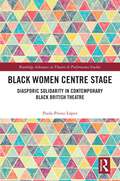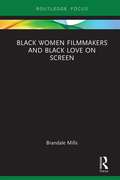- Table View
- List View
Black Wave: How Networks and Governance Shaped Japan’s 3/11 Disasters
by Daniel P. AldrichDespite the devastation caused by the magnitude 9.0 earthquake and 60-foot tsunami that struck Japan in 2011, some 96% of those living and working in the most disaster-stricken region of Tōhoku made it through. Smaller earthquakes and tsunamis have killed far more people in nearby China and India. What accounts for the exceptionally high survival rate? And why is it that some towns and cities in the Tōhoku region have built back more quickly than others? Black Wave illuminates two critical factors that had a direct influence on why survival rates varied so much across the Tōhoku region following the 3/11 disasters and why the rebuilding process has also not moved in lockstep across the region. Individuals and communities with stronger networks and better governance, Daniel P. Aldrich shows, had higher survival rates and accelerated recoveries. Less-connected communities with fewer such ties faced harder recovery processes and lower survival rates. Beyond the individual and neighborhood levels of survival and recovery, the rebuilding process has varied greatly, as some towns and cities have sought to work independently on rebuilding plans, ignoring recommendations from the national government and moving quickly to institute their own visions, while others have followed the guidelines offered by Tokyo-based bureaucrats for economic development and rebuilding.
Black Wave: How Networks and Governance Shaped Japan’s 3/11 Disasters
by Daniel P. AldrichDespite the devastation caused by the magnitude 9.0 earthquake and 60-foot tsunami that struck Japan in 2011, some 96% of those living and working in the most disaster-stricken region of Tōhoku made it through. Smaller earthquakes and tsunamis have killed far more people in nearby China and India. What accounts for the exceptionally high survival rate? And why is it that some towns and cities in the Tōhoku region have built back more quickly than others? Black Wave illuminates two critical factors that had a direct influence on why survival rates varied so much across the Tōhoku region following the 3/11 disasters and why the rebuilding process has also not moved in lockstep across the region. Individuals and communities with stronger networks and better governance, Daniel P. Aldrich shows, had higher survival rates and accelerated recoveries. Less-connected communities with fewer such ties faced harder recovery processes and lower survival rates. Beyond the individual and neighborhood levels of survival and recovery, the rebuilding process has varied greatly, as some towns and cities have sought to work independently on rebuilding plans, ignoring recommendations from the national government and moving quickly to institute their own visions, while others have followed the guidelines offered by Tokyo-based bureaucrats for economic development and rebuilding.
Black Wave: Saudi Arabia, Iran and the Rivalry That Unravelled the Middle East
by Kim Ghattas'Blistering' Sunday Times'Indispensable' Observer'Fascinating' The Times'Brilliant' Peter Frankopan'Revelatory' Lindsey HilsumA timely and unprecedented examination of how the modern Middle East unravelled, and why it started with the pivotal year of 1979'What happened to us?'For decades, the question has haunted the Arab and Muslim world, heard across Iran and Syria, Saudi Arabia and Pakistan, and in the author's home country of Lebanon. Was it always so? When did the extremism, intolerance and bloodletting of today displace the region's cultural promise and diversity? In Black Wave, award-winning journalist and author Kim Ghattas argues that the turning point in the modern history of the Middle East can be located in the toxic confluence of three major events in 1979: the Iranian revolution; the siege of the Holy Mosque in Mecca; and the Soviet invasion of Afghanistan. Before this year, Saudi Arabia and Iran had been working allies and twin pillars of US strategy in the region - but the radical legacy of these events made them mortal enemies, unleashing a process that transformed culture, society, religion and geopolitics across the region for decades to come.Drawing on a sweeping cast of characters across seven countries over forty years, Ghattas demonstrates how this rivalry for religious and cultural supremacy has fed intolerance, suppressed cultural expression, encouraged sectarian violence, birthed groups like Hezbollah and ISIS and, ultimately, upended the lives of millions. At once bold and intimate, Black Wave is a remarkable and engrossing story of the Middle East as it has never been told before.
Black Wealth / White Wealth: A New Perspective on Racial Inequality
by Melvin Oliver Thomas ShapiroThe award-winning Black Wealth / White Wealth offers a powerful portrait of racial inequality based on an analysis of private wealth. Melvin Oliver and Thomas Shapiro's groundbreaking research analyzes wealth - total assets and debts rather than income alone - to uncover deep and persistent racial inequality in America, and they show how public policies have failed to redress the problem. First published in 1995, Black Wealth / White Wealth is considered a classic exploration of race and inequality. It provided, for the first time, systematic empirical evidence that explained the racial inequality gap between blacks and whites. The Tenth Anniversary edition contains two entirely new and substantive chapters. These chapters look at the continuing issues of wealth and inequality in America and the new policies that have been launched in the past ten years. Some have been progressive while others only recreate inequality - for example the proposal to eliminate the estate tax. Compelling and also informative, Black Wealth / White Wealth is not just pioneering research. It is also a powerful counterpoint to arguments against affirmative action and a direct challenge to current social welfare policies that are tilted towards the wealthy.
Black Wealth / White Wealth: A New Perspective on Racial Inequality
by Melvin Oliver Thomas ShapiroThe award-winning Black Wealth / White Wealth offers a powerful portrait of racial inequality based on an analysis of private wealth. Melvin Oliver and Thomas Shapiro's groundbreaking research analyzes wealth - total assets and debts rather than income alone - to uncover deep and persistent racial inequality in America, and they show how public policies have failed to redress the problem. First published in 1995, Black Wealth / White Wealth is considered a classic exploration of race and inequality. It provided, for the first time, systematic empirical evidence that explained the racial inequality gap between blacks and whites. The Tenth Anniversary edition contains two entirely new and substantive chapters. These chapters look at the continuing issues of wealth and inequality in America and the new policies that have been launched in the past ten years. Some have been progressive while others only recreate inequality - for example the proposal to eliminate the estate tax. Compelling and also informative, Black Wealth / White Wealth is not just pioneering research. It is also a powerful counterpoint to arguments against affirmative action and a direct challenge to current social welfare policies that are tilted towards the wealthy.
Black, White, and Indian: Race and the Unmaking of an American Family
by Claudio SauntDeceit, compromise, and betrayal were the painful costs of becoming American for many families. For people of Indian, African, and European descent living in the newly formed United States, the most personal and emotional choices--to honor a friendship or pursue an intimate relationship--were often necessarily guided by the harsh economic realities imposed by the country's racial hierarchy. Few families in American history embody this struggle to survive the pervasive onslaught of racism more than the Graysons. Like many other residents of the eighteenth-century Native American South, where Black-Indian relations bore little social stigma, Katy Grayson and her brother William--both Creek Indians--had children with partners of African descent. As the plantation economy began to spread across their native land soon after the birth of the American republic, however, Katy abandoned her black partner and children to marry a Scottish-Creek man. She herself became a slaveholder, embracing slavery as a public display of her elevated place in America's racial hierarchy. William, by contrast, refused to leave his black wife and their several children and even legally emancipated them. Traveling separate paths, the Graysons survived the invasion of the Creek Nation by U.S. troops in 1813 and again in 1836 and endured the Trail of Tears, only to confront each other on the battlefield during the Civil War. Afterwards, they refused to recognize each other's existence. In 1907, when Creek Indians became U.S. citizens, Oklahoma gave force of law to the family schism by defining some Graysons as white, others as black. Tracking a full five generations of the Grayson family and basing his account in part on unprecedented access to the forty-four volume diary of G. W. Grayson, the one-time principal chief of the Creek Nation, Claudio Saunt tells not only of America's past, but of its present, shedding light on one of the most contentious issues in Indian politics, the role of "blood" in the construction of identity. Overwhelmed by the racial hierarchy in the United States and compelled to adopt the very ideology that oppressed them, the Graysons denied their kin, enslaved their relatives, married their masters, and went to war against each other. Claudio Saunt gives us not only a remarkable saga in its own right but one that illustrates the centrality of race in the American experience.
Black, White, and Indian: Race and the Unmaking of an American Family
by Claudio SauntDeceit, compromise, and betrayal were the painful costs of becoming American for many families. For people of Indian, African, and European descent living in the newly formed United States, the most personal and emotional choices--to honor a friendship or pursue an intimate relationship--were often necessarily guided by the harsh economic realities imposed by the country's racial hierarchy. Few families in American history embody this struggle to survive the pervasive onslaught of racism more than the Graysons. Like many other residents of the eighteenth-century Native American South, where Black-Indian relations bore little social stigma, Katy Grayson and her brother William--both Creek Indians--had children with partners of African descent. As the plantation economy began to spread across their native land soon after the birth of the American republic, however, Katy abandoned her black partner and children to marry a Scottish-Creek man. She herself became a slaveholder, embracing slavery as a public display of her elevated place in America's racial hierarchy. William, by contrast, refused to leave his black wife and their several children and even legally emancipated them. Traveling separate paths, the Graysons survived the invasion of the Creek Nation by U.S. troops in 1813 and again in 1836 and endured the Trail of Tears, only to confront each other on the battlefield during the Civil War. Afterwards, they refused to recognize each other's existence. In 1907, when Creek Indians became U.S. citizens, Oklahoma gave force of law to the family schism by defining some Graysons as white, others as black. Tracking a full five generations of the Grayson family and basing his account in part on unprecedented access to the forty-four volume diary of G. W. Grayson, the one-time principal chief of the Creek Nation, Claudio Saunt tells not only of America's past, but of its present, shedding light on one of the most contentious issues in Indian politics, the role of "blood" in the construction of identity. Overwhelmed by the racial hierarchy in the United States and compelled to adopt the very ideology that oppressed them, the Graysons denied their kin, enslaved their relatives, married their masters, and went to war against each other. Claudio Saunt gives us not only a remarkable saga in its own right but one that illustrates the centrality of race in the American experience.
Black, White or Mixed Race?: Race and Racism in the Lives of Young People of Mixed Parentage
by Ann Phoenix Barbara TizardThe number of people in racially mixed relationships has grown steadily over the last thirty years, yet these people often feel stigmatised and unhappy about their identities. The first edition of Black, White or Mixed Race? was a ground-breaking study: this revised edition uses new literature to consider what is now known about racialised identities and changes in the official use of 'mixed' categories. All new developments are placed in a historical framework and in the context of up-to-date literature on mixed parentage in Britain and the USA. Based on research with young people from a range of social backgrounds the book examines their attitudes to black and white people; their identity; their cultural origins; their friendships; their experiences of racism. This was the first study to concentrate on adolescents of black and white parentage and it continues to provide unique insights into their identities. It is a valuable resource for all those concerned with social work and policy.
Black, White or Mixed Race?: Race and Racism in the Lives of Young People of Mixed Parentage
by Ann Phoenix Barbara TizardThe number of people in racially mixed relationships has grown steadily over the last thirty years, yet these people often feel stigmatised and unhappy about their identities. The first edition of Black, White or Mixed Race? was a ground-breaking study: this revised edition uses new literature to consider what is now known about racialised identities and changes in the official use of 'mixed' categories. All new developments are placed in a historical framework and in the context of up-to-date literature on mixed parentage in Britain and the USA. Based on research with young people from a range of social backgrounds the book examines their attitudes to black and white people; their identity; their cultural origins; their friendships; their experiences of racism. This was the first study to concentrate on adolescents of black and white parentage and it continues to provide unique insights into their identities. It is a valuable resource for all those concerned with social work and policy.
The Black Widower: The Life and Crimes of a Sociopathic Killer
by Charles LaveryHe drugged his first wife and staged a fireball car crash, collecting a £200,000 insurance payout.He cheated his second wife of her life savings and attempted to kill her in a copycat crash.He faked cancer to dupe his third victim into a bigamous marriage, plotting her murder to steal her inheritance.He is Malcolm Webster: The Black Widower.After seventeen years of deception and brutality, Webster was finally jailed for thirty years in July 2011 at the climax of one of the longest trials in Scottish legal history. In this chilling book, award-winning journalist Charles Lavery documents the Black Widower’s life and crimes, giving a compelling insight into the mind of a man who killed for money and attempted to cover his tracks with drugs and fire.
Black Woman’s Burden: Commodifying Black Reproduction
by N. RousseauBlack Woman's Burden examines the historical endeavors to regulate Black female sexuality and reproduction in the United States through methods of exploitation, control, repression, and coercion. The myth of the "angry Black woman" has been built over generations through clever rhetoric and oppressive social policy. Here, Rousseau explores the continued impact of labeling and stereotyping on the development of policies that lead to the construction of national, racial, and gender identities for Black women.
Black Women, Agency, and the New Black Feminism (Routledge Research in Gender and Society)
by Maria del DavidsonThe powerful Beyoncé, formidable Rihanna, and the incalculable Nikki Minaj. Their images lead one to wonder: are they a new incarnation of black feminism and black women’s agency, or are they only pure fantasy in which, instead of having agency, they are in fact the products of the forces of patriarchy and commercialism? More broadly, one can ask whether black women in general are only being led to believe that they have power but are really being drawn back into more complicated systems of exploitation and oppression. Or, are black women subverting patriarchy by challenging notions of their subordinate and exploitable sexuality? In other words, ‘who is playing who’? Black Women, Agency, and the New Black Feminism identifies a generational divide between traditional black feminists and younger black women. While traditional black feminists may see, for example, sexualized images of black women negatively and as an impediment to progress, younger black women tend to embrace these new images and see them in a positive light. After carefully setting up this divide, this enlightening book will suggest that a more complex understanding of black feminist agency needs to be developed, one that is adapted to the complexities faced by the younger generation in today’s world. Arguing the concept of agency as an important theme for black feminism, this innovative title will appeal to scholars, teachers, and students interested in black feminist and feminist philosophy, identity construction, subjectivity and agency, race, gender, and class.
Black Women, Agency, and the New Black Feminism (Routledge Research in Gender and Society)
by Maria del DavidsonThe powerful Beyoncé, formidable Rihanna, and the incalculable Nikki Minaj. Their images lead one to wonder: are they a new incarnation of black feminism and black women’s agency, or are they only pure fantasy in which, instead of having agency, they are in fact the products of the forces of patriarchy and commercialism? More broadly, one can ask whether black women in general are only being led to believe that they have power but are really being drawn back into more complicated systems of exploitation and oppression. Or, are black women subverting patriarchy by challenging notions of their subordinate and exploitable sexuality? In other words, ‘who is playing who’? Black Women, Agency, and the New Black Feminism identifies a generational divide between traditional black feminists and younger black women. While traditional black feminists may see, for example, sexualized images of black women negatively and as an impediment to progress, younger black women tend to embrace these new images and see them in a positive light. After carefully setting up this divide, this enlightening book will suggest that a more complex understanding of black feminist agency needs to be developed, one that is adapted to the complexities faced by the younger generation in today’s world. Arguing the concept of agency as an important theme for black feminism, this innovative title will appeal to scholars, teachers, and students interested in black feminist and feminist philosophy, identity construction, subjectivity and agency, race, gender, and class.
Black Women Always: Conversations On Life, Culture And Creativity
by Kevin MoroskyA defining manual on using creativity as a tool for empowerment and allowing your personal identity to live in and guide all parts of your life, Kevin Morosky shares stories and inspiration from the women who have most influenced his creative path and explores the ways we can pursue success by implementing their wisdom in all aspects of our lives.
Black Women and the Changing Television Landscape
by Lisa M. AndersonBlack women's work in television has been, since the beginning, a negotiation. Black Women and the Changing Television Landscape explores the steps black women, as actors, directors, and producers, have taken to improve representations of black people on the small screen. Beginning with The Beulah Show, Anderson articulates the interrelationship between US culture and the televisual, demonstrating the conditions under which black women particularly, and black people generally, exist in popular culture.
Black Women and the Changing Television Landscape
by Lisa M. AndersonBlack women's work in television has been, since the beginning, a negotiation. Black Women and the Changing Television Landscape explores the steps black women, as actors, directors, and producers, have taken to improve representations of black people on the small screen. Beginning with The Beulah Show, Anderson articulates the interrelationship between US culture and the televisual, demonstrating the conditions under which black women particularly, and black people generally, exist in popular culture.
Black Women and White Women in the Professions: Occupational Segregation by Race and Gender, 1960-1980 (Perspectives on Gender)
by Natalie J. SokoloffFirst published in 1992. Routledge is an imprint of Taylor & Francis, an informa company.
Black Women and White Women in the Professions: Occupational Segregation by Race and Gender, 1960-1980 (Perspectives on Gender)
by Natalie J. SokoloffFirst published in 1992. Routledge is an imprint of Taylor & Francis, an informa company.
Black Women as Leaders: Challenging and Transforming Society
by Lori Latrice MartinThis book examines how black women have identified challenges in major social institutions across history and demonstrated adaptive leadership in mobilizing people to tackle those challenges facing black communities.Most studies about black women and social justice issues focus on the responses of black women to racism within the context of the feminist movement and/or the responses of black women to sexism in black liberation movements. Such discussions often fail to explore the ways in which black women's commitment to negotiating their racial, gender, and class identities, while engaged in the practice of leadership, is discouraged and ignored. Black Women as Leaders analyzes the commitment of contemporary black women to social justice issues from the perspective of adaptive leadership. It shows how black women are often forced into the public practice of leadership due to violent attacks from people with whom they are in engaged in interpersonal relationships. The book also breaks new ground by revealing how black women suffer from the devaluation and vilification of their engagement in the practice of leadership in private settings, such as their homes and selected religious and institutional settings.
Black Women as Leaders: Challenging and Transforming Society
by Lori Latrice MartinThis book examines how black women have identified challenges in major social institutions across history and demonstrated adaptive leadership in mobilizing people to tackle those challenges facing black communities.Most studies about black women and social justice issues focus on the responses of black women to racism within the context of the feminist movement and/or the responses of black women to sexism in black liberation movements. Such discussions often fail to explore the ways in which black women's commitment to negotiating their racial, gender, and class identities, while engaged in the practice of leadership, is discouraged and ignored. Black Women as Leaders analyzes the commitment of contemporary black women to social justice issues from the perspective of adaptive leadership. It shows how black women are often forced into the public practice of leadership due to violent attacks from people with whom they are in engaged in interpersonal relationships. The book also breaks new ground by revealing how black women suffer from the devaluation and vilification of their engagement in the practice of leadership in private settings, such as their homes and selected religious and institutional settings.
Black Women at Work: On Refusal and Recovery (Women and Society around the World)
by Wendi S. WilliamsDetails, and offers vignettes to illustrate, how patriarchy and white supremacy have restricted Black women at work, both historically and currently.Around water coolers and over glasses of wine, Black women come together and process the ways in which their labor is taken for granted and their excellence called into question. Black Women at Work: On Refusal and Recovery makes the direct connection between these contemporary experiences and the long legacy of Black labor exploitation. Through the trafficking and enslavement of Africans, European Americans laid the inhumane foundation of their present-day wealth and privilege and established oppressive labor dynamics for workers that persist to this day. In Black Women at Work, Wendi S. Williams moves the conversation beyond the stubborn audacity of inequity, focusing instead on the powerful history and example of Black women's labor and refusal practices and on the potent role that choice and voice can play in dismantling seemingly impenetrable systems of unfairness. Through the interweaving of personal narratives and social media reflections, Williams crafts a larger narrative of recovery and refusal that articulates a liberatory path toward recovery and reclamation through refusal-a path that will ultimately help to bring us all closer to freedom.
Black Women at Work: On Refusal and Recovery (Women and Society around the World)
by Wendi S. WilliamsDetails, and offers vignettes to illustrate, how patriarchy and white supremacy have restricted Black women at work, both historically and currently.Around water coolers and over glasses of wine, Black women come together and process the ways in which their labor is taken for granted and their excellence called into question. Black Women at Work: On Refusal and Recovery makes the direct connection between these contemporary experiences and the long legacy of Black labor exploitation. Through the trafficking and enslavement of Africans, European Americans laid the inhumane foundation of their present-day wealth and privilege and established oppressive labor dynamics for workers that persist to this day. In Black Women at Work, Wendi S. Williams moves the conversation beyond the stubborn audacity of inequity, focusing instead on the powerful history and example of Black women's labor and refusal practices and on the potent role that choice and voice can play in dismantling seemingly impenetrable systems of unfairness. Through the interweaving of personal narratives and social media reflections, Williams crafts a larger narrative of recovery and refusal that articulates a liberatory path toward recovery and reclamation through refusal-a path that will ultimately help to bring us all closer to freedom.
Black Women Centre Stage: Diasporic Solidarity in Contemporary Black British Theatre (Routledge Advances in Theatre & Performance Studies)
by Paola Prieto LópezThis book examines the political alliances that are built across the diaspora in contemporary plays written by Black women playwrights in the UK. Through the concept of creative diasporic solidarity, it offers an innovative theoretical approach to examine the ways in which the playwrights respond creatively to the violence and marginalisation of Black communities, especially Black women. This study demonstrates that theatre can act as a productive space for the ethical encounter with the Other (understood in terms of alterity, as someone different from the self) by examining the possibilities of these plays to activate the spectators’ responsibility and solidarity towards different types of violence experienced by Black women, offering alternative modes of relationality. The book engages with a range of contemporary works written by Black women playwrights in the UK, including Mojisola Adebayo, Theresa Ikoko, Diana Nneka Atuona, Gloria Williams, Charlene James, or Yusra Warsama, bringing to the fore a gendered and intersectional approach to the analysis of the texts. This book will be of great interest to students and scholars in contemporary theatre, gender studies and diaspora studies.
Black Women Centre Stage: Diasporic Solidarity in Contemporary Black British Theatre (Routledge Advances in Theatre & Performance Studies)
by Paola Prieto LópezThis book examines the political alliances that are built across the diaspora in contemporary plays written by Black women playwrights in the UK. Through the concept of creative diasporic solidarity, it offers an innovative theoretical approach to examine the ways in which the playwrights respond creatively to the violence and marginalisation of Black communities, especially Black women. This study demonstrates that theatre can act as a productive space for the ethical encounter with the Other (understood in terms of alterity, as someone different from the self) by examining the possibilities of these plays to activate the spectators’ responsibility and solidarity towards different types of violence experienced by Black women, offering alternative modes of relationality. The book engages with a range of contemporary works written by Black women playwrights in the UK, including Mojisola Adebayo, Theresa Ikoko, Diana Nneka Atuona, Gloria Williams, Charlene James, or Yusra Warsama, bringing to the fore a gendered and intersectional approach to the analysis of the texts. This book will be of great interest to students and scholars in contemporary theatre, gender studies and diaspora studies.
Black Women Filmmakers and Black Love on Screen (Routledge Transformations in Race and Media)
by Brandale N. MillsThis book offers a thorough analysis of how romantic love between Black men and women (referred to here as Black Love) is portrayed in Hollywood films, specifically from the perspective of Black female filmmakers. Using historical and contemporary images of Black female representation in the media as a foundation, the main themes of this text focus on the male gazes’ influence on Hollywood narratives, the necessity for the Black female perspective in Hollywood, and that perspective’s influence on ideologies and narratives.

